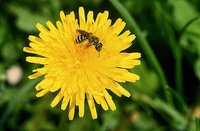Dandelion
|
|
| Dandelions | ||||||||||||
|---|---|---|---|---|---|---|---|---|---|---|---|---|
| Missing image Dandilion_plant.jpg Dandelion plant | ||||||||||||
| Scientific classification | ||||||||||||
| ||||||||||||
| Species | ||||||||||||
|
Taraxacum officinale |
The Dandelion (genus Taraxacum of the family Asteraceae) is a tap-rooted annual or biennial plant, found in most temperate zones.
| Contents |
Distribution and Etymology
Dandelions were originally widely distributed throughout northern Eurasia. They have been introduced to North America and Australia as weeds, and perhaps because of their many uses. They are now common plants throughout the temperate regions.
The name dandelion is a derivation of the Old French, dent-de-lion, literally "lion's tooth" on account of the sharply lobed leaves of the plant.
Botany
Dandelion_clock.jpg
The leaves are simple and basal, entire or lobed, forming a rosette above a central taproot. A bright yellow flower head is borne singly on a hollow "stem" (scape) which rises above the leaves and exudes a milky sap (latex) when broken. A rosette may produce more than one scape at a time. The flower head consists entirely of ray florets and matures into a globe of fine filaments that are usually distributed by wind, carrying away the seed-containing achenes. This globe (receptacle) is called the "dandelion clock", and blowing it apart is a popular pastime for children. The plant has a taproot. The flower head is surrounded by bracts (sometimes mistakenly called sepals) in two series. The outer bracts are erect until the flowers wither, then it hangs down, like the outer bracts always do.
Dandelion_Blackwell_0136.jpg
Some dandelions are apomictic and polyploidy is common. Some varieties drop the "parachute" (called a pappus, modified sepals) from the achenes. Ergo, there are "species" (apomictic and polyploid races) that grow only in a single meadow. This is one reason for there being a large number of described dandelion species, especially in Europe where botanists tend to be "splitters". As an example, some botanists list a few hundred species of dandelion from Finland alone. Others are inclined to "lump" these all into Taraxacum officinale.

Between the pappus and the achene, there is a stalk called beak, which elongates as the fruit matures. The beak breaks off from the achene quite easily.
Dandelions are so similar to catsear (Hypochaeris radicata) that catsear is also known as False Dandelion. Both plants carry similar flowers which form into windborne seeds. However, catsear flowering stems are forked and solid, whereas dandelions possess unforked stems that are hollow. Both plants have a rosette of leaves and a central taproot. However, the leaves of dandelions are jagged in appearance, whereas those of catsear are more lobe-shaped and hairy. Both plants have similar uses.
Dandelions are used as a food plant by the larvae of some species of Lepidoptera such as Small Fan-footed Wave, Riband Wave and The Flame.
Uses
While the dandelion is considered a weed by many gardeners, the plant does have several culinary and medicinal uses. Dandelions are grown commercially at a small scale as a leaf vegetable. The plant can be eaten cooked or raw in various forms, such as in soup or salad. They are probably closest in character to mustard greens. Usually the young leaves and unopened buds are eaten raw in salads, while older leaves are cooked. Raw leaves have a slightly bitter taste. Dandelion salad is often accompanied with hard boiled eggs.
Dandelion blossoms are used to make dandelion wine. Dandelions are high in vitamin A and also are a source of vitamin C. Ground roasted dandelion root is sometimes used as a coffee substitute. Drunk before meals, this is believed to stimulate digestive functions; this product is sold in some health food stores, often as a mixture of dandelion.
Dandelion root is a registered drug in Canada, sold as a diuretic. A leaf decoction can be drunk to "purify the blood," for the treatment of anemia, jaundice, and also for nervousness. The milky latex can be used as a mosquito repellent. Also, a dye can be obtained from the roots of the plant. Also, a dandelion's milk, when applied to warts, can help get rid of them without damaging the surrounding skin.
Species
- Taraxacum officinale (syn. T. vulgare), Common Dandelion. Found in many forms, but differs at least from the following species:
- Taraxacum albidum, a white-flowering Japanese dandelion.
- Taraxacum japonicum, Japanese dandelion. No ring of smallish, downward-turned leaves under the flowerhead.
- Taraxacum laevigatum (syn. T. erythrospermum), Red-seeded Dandelion — achenes reddish brown and leaves deeply cut throughout length. Inner bracts' tips are hooded.
- and others.
See also
- How to cook dandelions (http://textbook.wikipedia.org/wiki/Cookbook:Nature) ~ at Wikibooks
References
- Gail, Peter. The Dandelion Celebration: A Guide to Unexpected Cuisine. Cleveland, Ohio: Goosefoot Acres Press, 1994. ISBN 1879863510.
External links
- Dandelion Poetry, Folklore, Literature, and Pictures (http://fohn.net/dandelion-pictures/)
- Stalking the Wild Dandelion (http://www.wildmanstevebrill.com/Books.Folder/Stalking%20the%20Wild%20Dandelion/Stalking.html)
- Dandelion at Liber Herbarum II (http://www.liberherbarum.com/Pn0108.HTM)
- dandelion at Plants For A Future (http://www.scs.leeds.ac.uk/cgi-bin/pfaf/arr_html?Taraxacum+officinale)
- Dandelion at 'A modern herbal' by Mrs Grieve (1931) (http://botanical.com/botanical/mgmh/d/dandel08.html)
- Dandelion in Culpeper's 'The Complete Herbal' (http://www.bootlegbooks.com/NonFiction/Culpeper/Herbal/chap101.html)
- Picture (http://wetterchronik.de/mm/pflanzen/loewenzahn.htm)
- Dandelion Cough Syrup (http://www.selfsufficientish.com/coldflu.htm)bg:Глухарче
da:Mælkebøtte de:Löwenzahn et:Võilill eo:Leontodo fr:Pissenlit ja:タンポポ lt:Kiaulpienė nl:Paardebloem pt:Dente-de-leão ru:Одуванчик sv:Maskros zh:蒲公英
